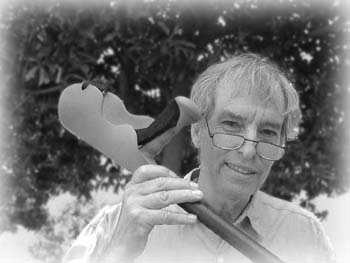![[Metroactive Features]](/features/gifs/feat468.gif)
![[Metroactive Features]](/features/gifs/feat468.gif)
[ Features Index | Metro | Metroactive Central | Archives ]
Citizen Cane
 Charlie Scurlock and Sandpiper Labs are in the business of making comfortable crutches for kids who need them--and it's not about the money. By Traci Hukill IT'S NOT HARD TO PICK CHARLIE Scurlock out of a crowd. He's wearing a floppy hat, just like he said he would, and he's deep in conversation with a tall bearded guy, who is presently insisting that an African American woman he knows never experienced racism until she moved to a black neighborhood. Scurlock listens thoughtfully to this account, his head bent, wispy white hair falling over his eyes. Everything about the 61-year-old retired physicist suggests quicksilver intelligence. He's small, tanned and athletic, possesses boundless energy and makes mental leaps with feline agility. His bright brown eyes never stop dancing. And he loves to talk. To listen to one of his stories is to step into a roomful of ricocheting ideas and somersaulting inspirations. One thing in particular makes Scurlock easy to spot on a sunny morning in May in front of a coffeehouse. He's the only person on this street in Palo Alto (or in California or the Western Hemisphere or anywhere on the Big Blue Marble, for that matter) who's holding a "proper" crutch, as he calls it--one engineered for comfort. The new model is lightweight, comfy, almost sporty--the Geo Metro of the crutch world. It's a kinder, gentler version of the clumsy forearm crutch with the steel cuff featured on posters for kids with polio and, most recently, as an aid to the First Bum Knee. "I mean, where the hell has this thing been all this time?" Scurlock blurts in delighted exasperation. "Kids with spina bifida and other degenerative disorders have very little strength in their lower bodies. They have to lean their entire weight on those crutches, and it's very hard on their wrists. Every couple of years, they have to have reconstructive surgery." Benjamin Mandac, a pediatric rehabilitation specialist working in Santa Clara County, confirms most of Scurlock's enthusiastic assertion. "Long-term crutch use--years and years of it--leads to wrist difficulties like carpal tunnel, tendonitis and overuse," he says, "though it's more well-documented in the adult literature. [A different crutch] would potentially be helpful in terms of prevention of difficulties." Scurlock came face to face with the inadequacies of forearm crutches while volunteering at a community rehabilitation center for kids with spina bifida, multiple sclerosis, muscular dystrophy and similar diseases. Not only did the crutches cause wrist pain, but the steel cuffs tended to bruise the kids' arms when they fell down. When an orthopedic nurse suggested to Scurlock that he design a new crutch, he rounded up a few buddies and went to work. In the new crutch, designed by Michael Wise, an ergonomically designed channel of molded plastic cradles the back of the wrist and forearm, while a loose-fitting band of elastic replaces the function of the steel cuff, allowing the user to do things like open doors without first having to put the crutch down. The grips mold specifically to left and right hands and feature orthopedic gel--the stuff in padded bicycle seats--to help cushion the hand and wrist. Best of all, they're angled downward a few degrees to align hands naturally rather than resting perpendicular to the floor. "We're not talking brain surgery here!" Scurlock exclaims. "There's strength in alignment. All this kung fu stuff you hear about--it's partly about physical strength, but mostly it's about alignment. So we aligned the wrists naturally with the body." Sandpiper Labs, the Palo Altobased nonprofit team that created the crutch, is working with a patent lawyer to establish rights to the design. The group is also seeking a major donation of $500,000 to finance the first production run of 1,000,000 crutches, an endeavor that team member and retired Boeing veep of production Jim Carnahan will oversee. As soon as Sandpiper has the money, the lab will build 15 crutches and test them to get the bugs out first. So what makes a former Rand Corporation physicist who once volunteered for experimental surgery to remove an "inoperable" brain tumor throw his energy into making comfortable crutches for kids most people find it easier to ignore? "I have no choice," he beams, tears inexplicably filling his eyes. "Things go wrong when I'm not doing what I'm supposed to. I get sick. I get in trouble." Here's to being a good citizen, then, and doing the right thing. [ Metro | Metroactive Central | Archives ]
| ||||||||||||||||||||||||||||||
This page was designed and created by the Boulevards team.
Copyright © 1997 Metro Publishing, Inc.